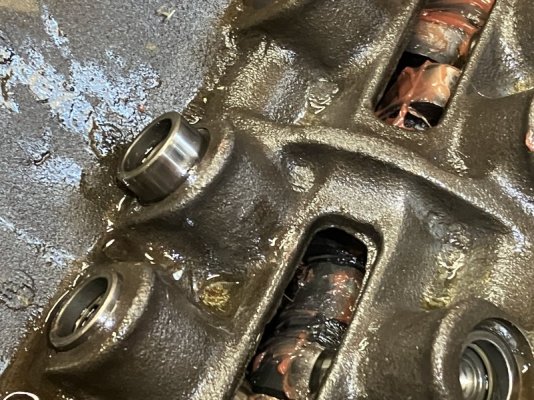I got a little more done today.
I changed out the checking springs....
Oil pump pickup is in.
I don't know if this is common practice but I smeared pipe dope on the threads.
With the Jigsaw 383, I used THIS on the oil pan and windage tray...
The 383 does not leak.
Hopefully this one will retain the oil on the inside too.
I lashed the valves. The cam card calls for .020 intake and .022 exhaust. Since I have aluminum heads, I set the lash cold... .006 tighter to .014 intake and .016 exhaust to account for the heads expanding during warm-up.
I used a cheap mechanical oil pressure gauge and pre-oiled the system using a 1/2" Milwaukee drill. At speed, it showed 50 psi. I rotated the crank slowly while running the drill. Oil made it to the top...
With a little luck, I am hoping to be able to get the whole shebang back in the car by Sunday afternoon. Plenty left to do, though.
I want to re-verify the bell housing runout. It should be fine but I want to be sure.
Motor mounts, fuel pump, water pump, alternator, crank pulley, idler pulley....
Flywheel, clutch, pressure plate and bell housing too.
I already cleaned all the bolts and other hardware so assembly should go quickly. I'll probably repaint the headers and pulleys.
I have thought of how this whole project should result in the car being faster than ever.
The engine will have slightly lower compression but real
quench. This should allow me to run the timing a bit further out. I had it at 18-19 initial and
32 -33 total. It might benefit from 2 more degrees of total timing, it might not.
@Beanhead came through with an FBO spark box and coil that I'll swap in after the car is up and running. This cam is much bigger than the '528....that will result in some increase. The fresh piston rings should improve matters. The standard volume oil pump draws less HP than the high volume pumps that I have used before. The shorter rear tires will have the effect of a gear swap from 3.55 to 3.86.
I'm still anxious to see how well the hydroboost brakes work. After the engine is back in, I'll need to have hydraulic lines made.
















